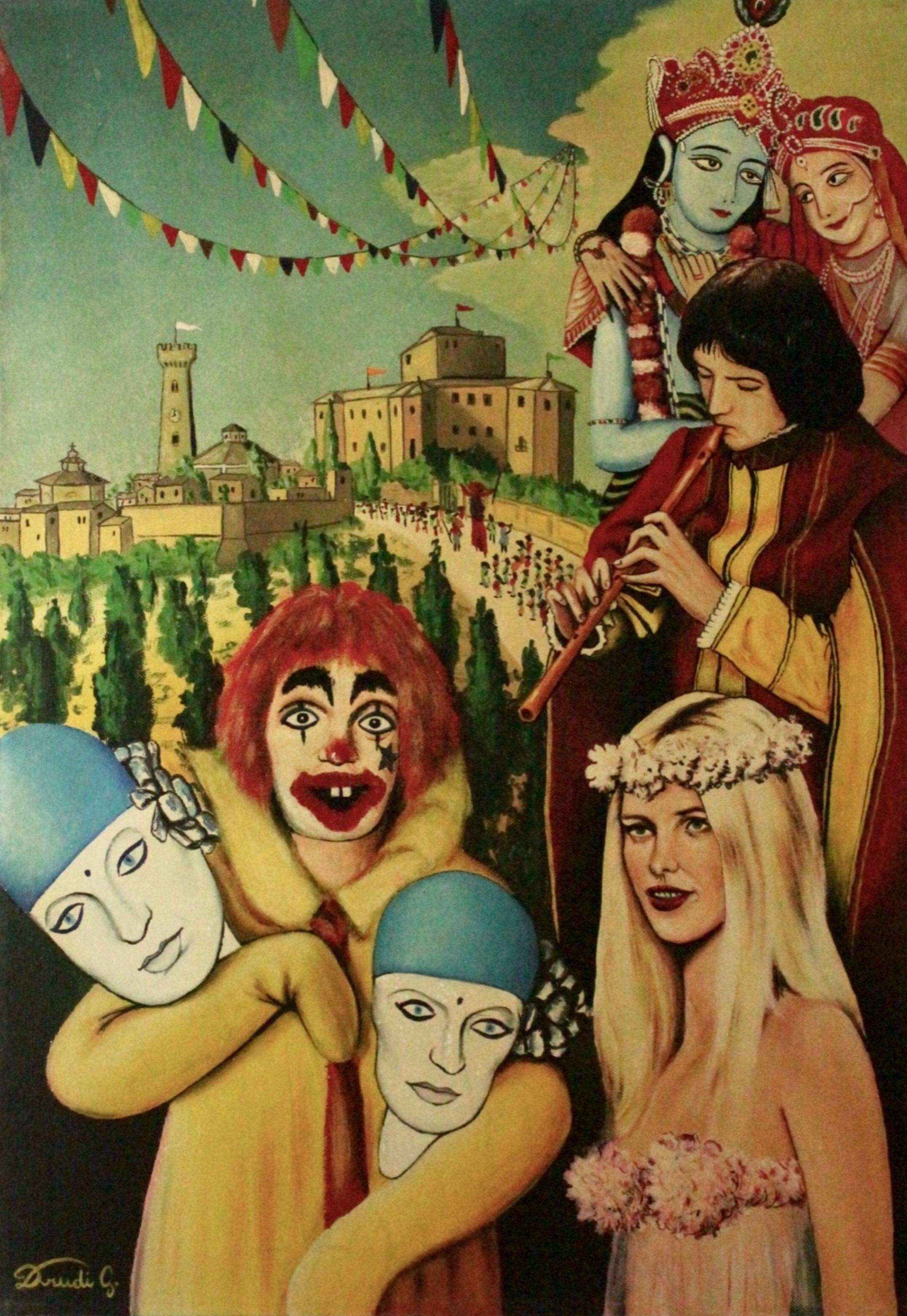THEATER IN THE SQUARE, COME ALL
1978, 50x70cm, Glossy oil on canvas

Various characters from all eras, such as a clown, Ilona Staller, Krishna, and a medieval musician… bring the Theater in the square to life. In the background is the town of Santarcangelo di Romagna.
“Theater in the Square, Come All” is a work from 1978, created with glossy oil on canvas, that captures the magic of itinerant theater in a square animated by characters from different cultural and artistic traditions. In the background, the village of Santarcangelo di Romagna frames this lively and symbolic scene, in which epochs, myths, and icons of entertainment merge.
Detailed description of the characters:
The clown with masks:
At the center of the work stands a figure with a heavily made-up face, red hair, and an expression halfway between the comic and the grotesque. He wears a yellow costume with enormous gloves and holds two white masks with enigmatic faces, evoking the duality between reality and fiction, joy and melancholy, typical of theater. This figure might recall Harlequin, a symbol of the Commedia dell’Arte, reinterpreted in a modern key.
Ilona Staller (Cicciolina):
At the bottom right, a blonde female figure with a crown of flowers and a light dress clearly recalls Ilona Staller, known as Cicciolina. Her angelic and sensual appearance, characterized by light colors and floral details, seems to fit into this theatrical world as an incarnation of beauty and freedom of expression, elements that have marked her artistic and political career.
The medieval musician:
Behind the clown and Cicciolina, a young man in Renaissance clothing plays a recorder, evoking the musical tradition of European courts. His role in the scene recalls the function of music in square theater, which accompanies and amplifies the emotions of the show.
The Indian deities:
In the background, a blue-skinned figure, Krishna, is embraced by a woman adorned with jewelry and clothes typical of Hindu iconography. This detail introduces an exotic and spiritual element, emphasizing how theater and art are universal, capable of connecting worlds and cultures that appear distant.
The celebrating village:
The scene is framed by the background of Santarcangelo di Romagna, with its medieval towers, uphill streets, and the celebrating crowd. The colorful flags decorating the sky reinforce the sense of celebration and recall the atmosphere of ancient village festivals, where artists and acrobats brought itinerant shows to the squares.
Interpretation:
This work is a celebration of theater as a meeting place between reality and representation, history and modernity, East and West. The characters are suspended between past and present, between myth and everyday reality, creating a fresco that invites the viewer to reflect on the power of art and imagination.

Various characters from all eras, such as a clown, Ilona Staller, Krishna, and a medieval musician… bring the Theater in the square to life. In the background is the town of Santarcangelo di Romagna.
“Theater in the Square, Come All” is a work from 1978, created with glossy oil on canvas, that captures the magic of itinerant theater in a square animated by characters from different cultural and artistic traditions. In the background, the village of Santarcangelo di Romagna frames this lively and symbolic scene, in which epochs, myths, and icons of entertainment merge.
Detailed description of the characters:
The clown with masks:
At the center of the work stands a figure with a heavily made-up face, red hair, and an expression halfway between the comic and the grotesque. He wears a yellow costume with enormous gloves and holds two white masks with enigmatic faces, evoking the duality between reality and fiction, joy and melancholy, typical of theater. This figure might recall Harlequin, a symbol of the Commedia dell’Arte, reinterpreted in a modern key.
Ilona Staller (Cicciolina):
At the bottom right, a blonde female figure with a crown of flowers and a light dress clearly recalls Ilona Staller, known as Cicciolina. Her angelic and sensual appearance, characterized by light colors and floral details, seems to fit into this theatrical world as an incarnation of beauty and freedom of expression, elements that have marked her artistic and political career.
The medieval musician:
Behind the clown and Cicciolina, a young man in Renaissance clothing plays a recorder, evoking the musical tradition of European courts. His role in the scene recalls the function of music in square theater, which accompanies and amplifies the emotions of the show.
The Indian deities:
In the background, a blue-skinned figure, Krishna, is embraced by a woman adorned with jewelry and clothes typical of Hindu iconography. This detail introduces an exotic and spiritual element, emphasizing how theater and art are universal, capable of connecting worlds and cultures that appear distant.
The celebrating village:
The scene is framed by the background of Santarcangelo di Romagna, with its medieval towers, uphill streets, and the celebrating crowd. The colorful flags decorating the sky reinforce the sense of celebration and recall the atmosphere of ancient village festivals, where artists and acrobats brought itinerant shows to the squares.
Interpretation:
This work is a celebration of theater as a meeting place between reality and representation, history and modernity, East and West. The characters are suspended between past and present, between myth and everyday reality, creating a fresco that invites the viewer to reflect on the power of art and imagination.